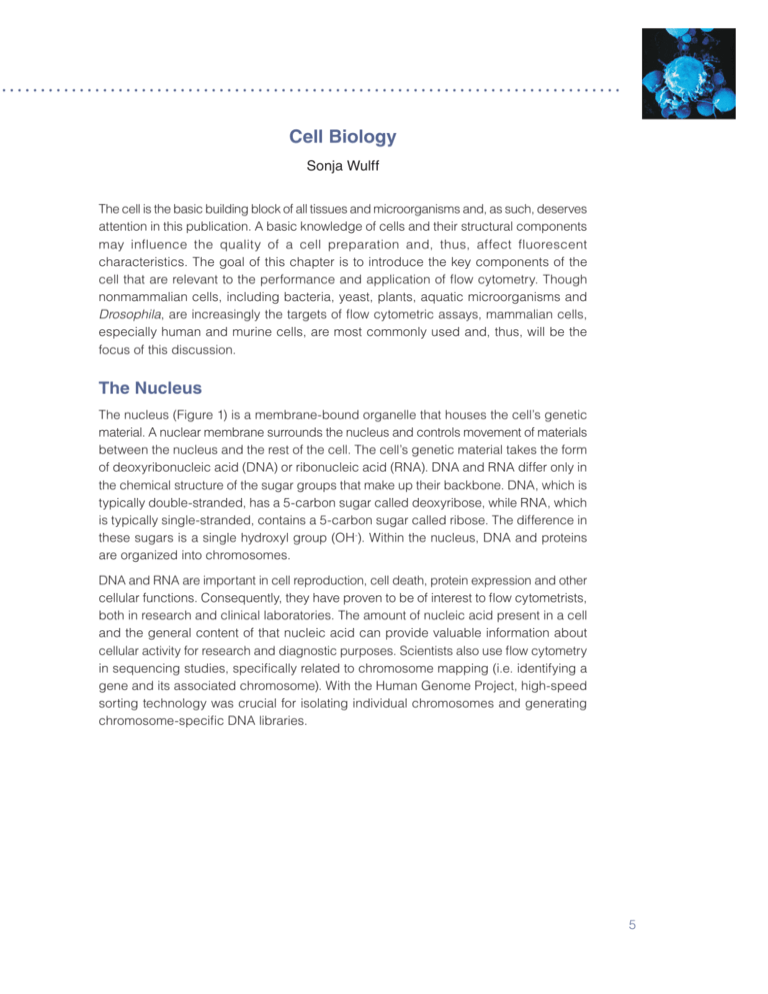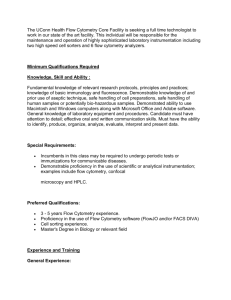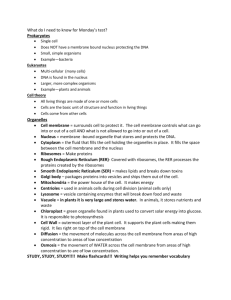Cell Biology
advertisement

Cell Biology Sonja Wulff The cell is the basic building block of all tissues and microorganisms and, as such, deserves attention in this publication. A basic knowledge of cells and their structural components may influence the quality of a cell preparation and, thus, affect fluorescent characteristics. The goal of this chapter is to introduce the key components of the cell that are relevant to the performance and application of flow cytometry. Though nonmammalian cells, including bacteria, yeast, plants, aquatic microorganisms and Drosophila, are increasingly the targets of flow cytometric assays, mammalian cells, especially human and murine cells, are most commonly used and, thus, will be the focus of this discussion. The Nucleus The nucleus (Figure 1) is a membrane-bound organelle that houses the cell’s genetic material. A nuclear membrane surrounds the nucleus and controls movement of materials between the nucleus and the rest of the cell. The cell’s genetic material takes the form of deoxyribonucleic acid (DNA) or ribonucleic acid (RNA). DNA and RNA differ only in the chemical structure of the sugar groups that make up their backbone. DNA, which is typically double-stranded, has a 5-carbon sugar called deoxyribose, while RNA, which is typically single-stranded, contains a 5-carbon sugar called ribose. The difference in these sugars is a single hydroxyl group (OH-). Within the nucleus, DNA and proteins are organized into chromosomes. DNA and RNA are important in cell reproduction, cell death, protein expression and other cellular functions. Consequently, they have proven to be of interest to flow cytometrists, both in research and clinical laboratories. The amount of nucleic acid present in a cell and the general content of that nucleic acid can provide valuable information about cellular activity for research and diagnostic purposes. Scientists also use flow cytometry in sequencing studies, specifically related to chromosome mapping (i.e. identifying a gene and its associated chromosome). With the Human Genome Project, high-speed sorting technology was crucial for isolating individual chromosomes and generating chromosome-specific DNA libraries. 5 Guide to Flow Cytometry Golgi complex Smooth endoplasmic reticulum Nucleus Mitochondrion Rough endoplasmic reticulum Plasma membrane Ribosomes Figure 1. The Cell The Cytoplasm The cytoplasm (Figure 1) is the site of most of the cell’s housekeeping functions, which are carried out as directed by the nucleus. The appearance of the cytoplasm can vary greatly from cell to cell and, thus, plays a key role in distinguishing different types of cells by microscopy. The cytoplasm also contains several common structures that provide valuable information about the cell and its activity. The focus here will be on structures that are detectable by flow cytometry. The endoplasmic reticulum is a series of membrane-bound channels that transport secretory products for use in the cell or for export out of the cell. The Golgi apparatus is a stack of membranes that modify, store and route products of the endoplasmic reticulum. Together, the endoplasmic reticulum and Golgi are primarily responsible for the proper sorting of lipids and proteins in cells. They also have critical roles in signal transductionassociated lipid trafficking and a variety of transport-related human diseases. In flow cytometry laboratories, they also can be used in studies related to cholesterol and intracellular expression of immunoregulatory proteins, known as cytokines. Another cytoplasmic structure of particular interest to flow cytometrists is the mitochondrion. The primary function of mitochondria, which can make up as much as 10% of the cell’s volume, is energy production through oxidative phosphorylation and lipid oxidation. They also are involved in apoptosis, intracellular calcium homeostasis, and production of urea, heme and steroids. Their abundance and morphology vary with cell type, reproductive stage and activity level. A variety of flow cytometric probes are available for monitoring mitochondrial morphology and function, which can provide valuable information about metabolic and neurodegenerative disease, drug resistance, fertilization, cell signaling and a number of other topics that are relevant to both clinical and research laboratories. 6 Cell Biology The Membrane The entire cell is enclosed by a plasma membrane, which serves as a selective barrier to regulate the cell’s chemical composition. The plasma membrane is of particular interest in flow cytometry for a number of reasons. First, it anchors surface proteins, or antigens, that can serve as cell identifiers. These antigens define characteristics about a cell, such as function, lineage and developmental stage. They are so numerous that the scientific world has adopted a classification system based on assigned cluster of differentiation, or CD, numbers. For instance, CD4 is a marker on the surface of helper T cells, while CD56 is a marker on the surface of natural killer (NK) cells. In addition to CD antigens, the cell surface contains countless receptor molecules that can trigger complex signal transduction pathways inside the cell upon binding of specific ligands. Flow cytometers can detect the presence and relative numbers of these receptors and antigens using fluorescently labeled monoclonal antibodies directed against them. Additional protocols exist to assess how close these molecules are to each other and what, if any, interactions they have. Flow cytometry also can be used to measure membrane potential, or the charge difference across the membrane generated by the relative internal and external concentrations of ions such as potassium, sodium and chloride. Changes in membrane potential play a critical role in many physiological processes, including nerve-impulse propagation, muscle contraction, cell signaling and ion-channel gating. Specific flow cytometric probes are available to directly look at ion channel activity, most commonly for calcium, or Ca2+. Intracellular Ca2+ levels regulate numerous cellular processes, including gene expression, cellular reproduction and motility. At times in flow cytometry, cell membranes can complicate experiments. In situations where the goal is to detect intracellular proteins, processes and materials, dyes and labeled antibodies must be able to cross the membrane. This precludes the use of certain dyes and fluorochromes and requires special cell preparation. Cell Preparation Special consideration must be given to samples destined for the flow cytometer. While an in-depth discussion of these considerations and specific protocols is not possible in this publication, a brief mention of some key concepts follows. For more information on staining and antibody handling, see Chapter 5. Disaggregation Single-cell suspensions are required for all flow cytometric assays. As such, certain types of cells (e.g. leukocytes in blood) are ideally suited for flow cytometry. However, this requirement does not preclude flow cytometric analysis of solid tumors or other tissue samples. A number of protocols are available for disagreggating tissue samples into suitable single-cell suspensions (Figure 2). These protocols typically involve either enzymatic digestion (e.g. collagenous) or mechanical chopping and filtering. Cultured cells may also need special treatment — typically gentle trypsin digestion — as many cell lines grow attached to the plastic surface of a culture flask. In all situations, removing debris, dead cells and cell clumps is essential to a successful experiment. 7 Guide to Flow Cytometry A B C Figure 2. Flow Cytometric Analysis of a Solid Tumor. A breast cancer specimen analyzed by immunohistochemistry was found to be negative for estrogen receptor expression (A) but positive for expression of the HER-2/neu oncogene (B). Upon disaggregation, multiparametric flow cytometry (C) looked at expression of both proteins, along with cell growth parameters. Data courtesy of Mathie P. G. Leers, PhD, Atrium Medical Center, Netherlands Enrichment Historically, when dealing with rare populations of interest (e.g. 5% or less), it has been necessary to enrich, or concentrate, these populations to reduce the length of a sort or analysis. Methods of enrichment vary greatly but include centrifugation, density gradients, magnetic particle separation and complement-mediated lysis. With the advent of high-speed flow cytometers, these procedures are no longer necessary for successful rare-event detection. With instruments that can process 100,000 events per second, it has become acceptable not to perform enrichment at all. Eliminating this step boosts laboratory productivity, minimizes potentially harmful cellular manipulations and ensures more accurate rare-population statistics. Membrane Permeabilization Though the plasma membrane is impermeable to large molecules, such as antibodies, flow cytometry can still provide a means of detecting intracellular proteins if appropriate cell preparation protocols are followed. Typically, this approach involves cell fixation, typically with formaldehyde, to stabilize the proteins, and subsequent disruption of the membrane with detergents. Fixative and detergent choice, as well as incubation times, will vary depending on the intracellular protein of interest. References 8 1. Ashcroft RG, Lopez PA. Commercial high-speed machines open new opportunities in high-throughput flow cytometry. J Immunol Methods 2000; 243: 13-24. 2. Campbell NA. Biology. 3rd ed. Redwood City, CA: The Benjamin/Cummings Publishing Company, Inc.; 1993. 3. Givan AL. Flow cytometry: first principles. 2nd ed. New York: Wiley-Leiss; 2001. 4. Handbook of fluorescent probes and research products. 1996. Available at: http://www.probes.com/handbook. Accessed March 31, 2004. 5. Ormerod MG. Flow cytometry: practical approach. 3rd ed. Surry, UK: Oxford University Press; 2000. 6. Shapiro HM. Practical flow cytometry. 4th ed. Hoboken, NJ: Wiley-Liss; 2003.







